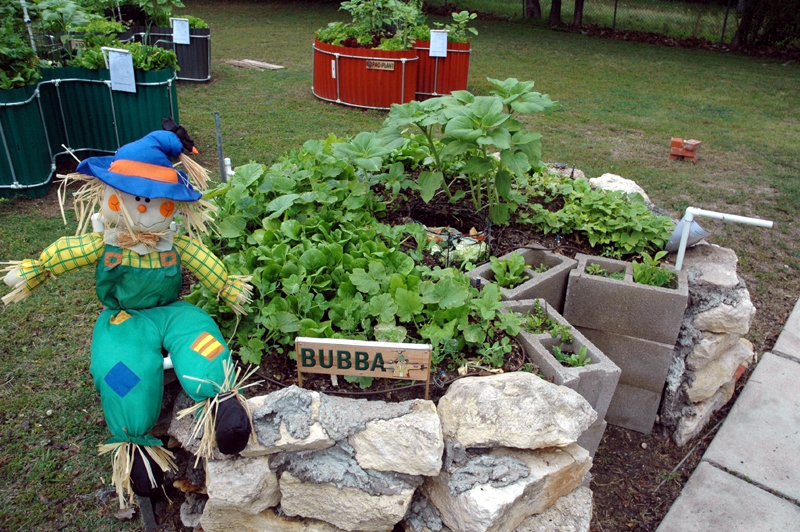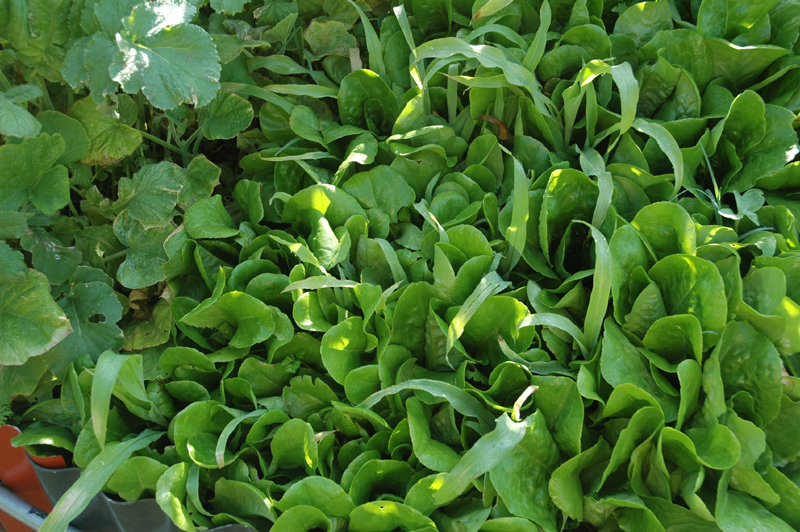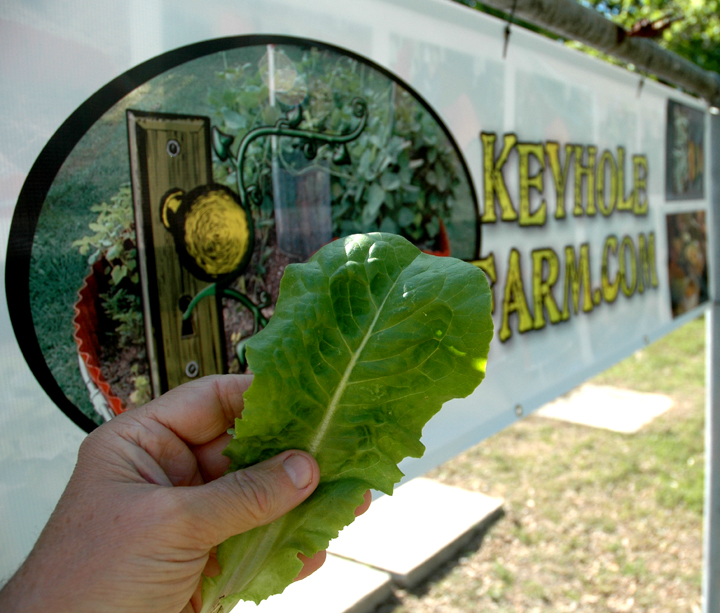
 On April 16, Keyhole Farm participated in Dr. Deb’s Keyhole Garden Tour (A Garden Adventure in Bosque County, Texas) where approximately 225 garden enthusiasts primarily from different parts of Texas toured numerous keyhole gardens near Clifton, including our seven, during a period of about five hours.
On April 16, Keyhole Farm participated in Dr. Deb’s Keyhole Garden Tour (A Garden Adventure in Bosque County, Texas) where approximately 225 garden enthusiasts primarily from different parts of Texas toured numerous keyhole gardens near Clifton, including our seven, during a period of about five hours.
 Following the tour was a lecture by Dr. Deb Tolman, Ph.D. who specializes in environmental sciences/resources and geography.
Following the tour was a lecture by Dr. Deb Tolman, Ph.D. who specializes in environmental sciences/resources and geography.
She has more than 30 years’ experience in academic research and landscape design plus extensive training in the plant sciences, economics, and environmental education.
 S
S he owns Dr. Deb’s Habitats and Avant Gardens, a multi-purpose business with the mission of developing sustainable coaching. She is co-director of the Silo Project which is dedicated to Sustainable Information and Learning Opportunities.
he owns Dr. Deb’s Habitats and Avant Gardens, a multi-purpose business with the mission of developing sustainable coaching. She is co-director of the Silo Project which is dedicated to Sustainable Information and Learning Opportunities.
The tour was developed with the help of the Clifton Chamber of Commerce.
The various farms featured different construction techniques.
Keyhole Farm showed both its traditional garden made of cinder blocks and rocks, plus six made from our kits. Our gardens were planted in waves this year, from about five to seven weeks ago, depending on each particular garden, which is a little earlier than usual, meaning that we had a couple of substantial freezes to contend with along the way.

 Overall, the gardens were fairly lush the day of the tour and we enjoyed answering questions and describing how our gardens work.
Overall, the gardens were fairly lush the day of the tour and we enjoyed answering questions and describing how our gardens work.
The Clifton location is our primary experiment station consisting of gardens that range in age of over five years to new this year. Our most current experiment is the attempt to grow plants out the side of one of our gardens to see how they do.

 In the future, I would like to experiment with the addition of “sound” to a garden, the vibrations possibly enhancing aeration. There are several potential experiments on our to-do list that I hope we can get to soon.
In the future, I would like to experiment with the addition of “sound” to a garden, the vibrations possibly enhancing aeration. There are several potential experiments on our to-do list that I hope we can get to soon.
Three representatives from Keyhole Farm answered questions and showed our gardens, including my brother Lyndell Smith, Ronnie Murphy, and myself. I learned numerous techniques from some of the visitors who have considerable experience with gardening.
I really enjoyed the tour and those who came to witness ou
really enjoyed the tour and those who came to witness ou r gardens.
r gardens.
With this update numerous photographs appear, very small on the surface. If you want to see them closer, just click on an image and it should enlarge. They were taken during the tour or thereabouts (a few right after).
Updating this website can be a little tricky since after photos are taken and processed (sized, etc.), the plants have grown again so I am tempted to dump those photos and take newer ones, sort of a never-ending cycle. If you pay close attention to your plants you can detect growth sometimes twice a day or at least daily. They are constantly changing.

 Our plants are situated very close together and so far we are having good luck with them.
Our plants are situated very close together and so far we are having good luck with them.
Since I planted a bigger variety than usual this year, I am having some difficulty telling exactly what is what, although I do map the seeds out on a chart first. I ju st don
st don ‘t always follow it.
‘t always follow it.
For instance, I had one fairly tall plant that had some little purple flowers on it. It was in the area where I thought I had planted sweet potatoes or a type of tomato or rat’s tail. When I was asked what it was, I had no clue. One visitor said it’s not a tomato plant and another said it’s not sweet potato. Then a woman came up and told me they are turnips. She smelled of its base and said, “Yes, turnips.”
I ha d some people ask me i
d some people ask me i f there are any plants I have not had success with.
f there are any plants I have not had success with.
My response was “potatoes.” I commented that I was possibly doing them incorrectly, but potatoes was usually my only problem crop. I thought I had planted them this year in one garden and again saw no results, but a man came up and admired my potatoes in another garden and provided me tips on harvesting them. They look terrific so far. I had simply forgotten where I planted them and did not realize what they were at this stage of growth.

 After the tour, I picked some lettuce (iceberg and butter crunch) and some spinach leaves to make a salad for supper. Delish!
After the tour, I picked some lettuce (iceberg and butter crunch) and some spinach leaves to make a salad for supper. Delish!
The green beans are looking extremely healthy and the various types of sugar peas are doing well, too, and are starting to flower. It looks like a bumper crop of sunflowers is headed my way, too.
Watermelons, pumpkins, and strawberries are erupting from the side of the experimental garden and we have been picking asparagus for some time now.

 When some crops quit making, we generally pull them up and plant something else there. In the summer when it gets hotter, okra and black-eyed peas do exceptionally well. So far this year, we have put about 60 or 70 different varieties of crops into these seven keyholes. It will be interesting to see how they do.
When some crops quit making, we generally pull them up and plant something else there. In the summer when it gets hotter, okra and black-eyed peas do exceptionally well. So far this year, we have put about 60 or 70 different varieties of crops into these seven keyholes. It will be interesting to see how they do.
If you are interested in keyhole gardening, it is far from too late to get started since growing seasons can be quite long, depending upon your climate. Some crops do well in colder climates, some prefer it hot. It’s largely a matter of choosing the right crop for a particular time of the year.

 The photos on this page are in no particular order. Some are distant shots of our gardens and some are close-ups of some of the crops. Like I mentioned earlier, just click on the small image to blow it up and then click odd the image to make it go away.
The photos on this page are in no particular order. Some are distant shots of our gardens and some are close-ups of some of the crops. Like I mentioned earlier, just click on the small image to blow it up and then click odd the image to make it go away.
Of note, my brother has suggested each year that we create sequence images of the plants growing then speed them up so that the plants show fast growth, like fast motion. I set an analog camera up in a breezeway and filmed 10 seconds each day and had some low resolution security cameras that I did likewise. I also set up an area outside with two poles in the ground for my feet and shot daily still images of one garden, trying to hand-hold the camera steadily to make it work.
 This past week I looked at the security camera films but the quality is not good at all. On the analog camera, I realized that the videotape
This past week I looked at the security camera films but the quality is not good at all. On the analog camera, I realized that the videotape  inside had already been used up when I started this, so I got nothing. I have been able to put together the still shots into a film, but the images bounce a little because of the hand-held camera. I will try to get it posted soon.
inside had already been used up when I started this, so I got nothing. I have been able to put together the still shots into a film, but the images bounce a little because of the hand-held camera. I will try to get it posted soon.
If anyone wants to tour our experiment station, just give me a call at 254-652-9483 or e-mail me at smith@keyholefarm.com and we can make arrangements.


